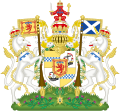Duke of Rothesay
| Duke of Rothesay | |
|---|---|
 |
|
| Style | His Royal Highness Sir |
| Residence | Clarence House |
| Term length | Life tenure or until accession as Sovereign |
| Inaugural holder | David Stewart |
| Website | www.princeofwales.gov.uk |
Duke of Rothesay (Scottish Gaelic: Diùc Baile Bhòid, Scots: Duik o Rothesay) is a title of the heir apparent to the British throne, currently Prince Charles. It was a title of the heir apparent to the throne of the Kingdom of Scotland before 1707, of the Kingdom of Great Britain from 1707 to 1801, and now of the United Kingdom of Great Britain and Northern Ireland. It is the title mandated for use by the heir apparent when in Scotland, in preference to the titles Duke of Cornwall (which also belongs to the eldest living son of the monarch, when and only when he is also heir apparent, by right) and Prince of Wales (traditionally granted to the heir apparent), which are used in the rest of the United Kingdom and overseas. The Duke of Rothesay also holds other Scottish titles, including those of Earl of Carrick, Baron of Renfrew, Lord of the Isles and Prince and Great Steward of Scotland. The title is named after Rothesay on the Isle of Bute, Argyll and Bute, but is not associated with any legal entity or landed property, unlike the Duchy of Cornwall.
David Stewart, Duke of Rothesay, the son of Robert III of Scotland, King of Scots, first held the dukedom from its creation in 1398. After his death, his brother James, later King James I, received the dukedom. Thereafter, the heir-apparent to the Scottish Crown held the dukedom; an Act of the Scottish Parliament passed in 1469 confirmed this pattern of succession.
...
Wikipedia

